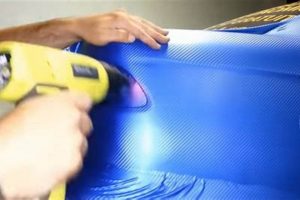A “do-it-yourself” backpack refers to the creation of a carrying bag for personal belongings, constructed by an individual rather than purchased pre-made from a retailer. This process typically involves selecting materials such as fabric, straps, and closures, followed by cutting, sewing, and assembling them according to a chosen design or pattern. An example could involve repurposing old clothing or canvas into a functional rucksack suitable for carrying books or hiking supplies.
The practice of crafting one’s own carrying solution provides several advantages. It offers the opportunity for customization, allowing the maker to tailor the size, features, and aesthetics to specific needs and preferences. Furthermore, it can present a cost-effective alternative to commercial products, particularly when utilizing recycled or repurposed materials. Historically, crafting personal carrying devices predates mass manufacturing, reflecting a tradition of resourcefulness and self-sufficiency.
The subsequent sections will delve into the various materials suitable for construction, explore different design options and essential sewing techniques, and provide guidance on creating durable and functional carrying solutions. Considerations for ergonomics and load distribution will also be addressed, along with tips for adding specialized features and ensuring long-term usability.
“Do-It-Yourself” Backpack Construction Tips
The following section presents several key considerations for the successful design and fabrication of a carrying solution. Attention to detail and careful material selection are paramount for ensuring durability and functionality.
Tip 1: Material Selection is Crucial. Employ heavy-duty fabrics like canvas, Cordura, or ripstop nylon for the main body. These materials offer superior abrasion resistance and longevity. Lightweight alternatives such as packcloth are suitable for lining or less stressed areas.
Tip 2: Reinforce Stress Points. Areas where straps attach to the pack body, or where closures are located, experience significant strain. Reinforce these points with bar tack stitching, webbing overlays, or leather patches.
Tip 3: Pay Attention to Seam Construction. Employ felled seams or bound seams to prevent fraying and enhance durability. A serger can quickly finish raw edges, but is not strictly necessary if seams are properly reinforced.
Tip 4: Select Appropriate Hardware. Use high-quality buckles, zippers, and D-rings. Cheap hardware is prone to failure, compromising the integrity of the final product. Consider metal hardware for demanding applications.
Tip 5: Prioritize Ergonomics. Incorporate padded shoulder straps and a sternum strap to distribute weight effectively. A padded back panel can improve comfort and ventilation. Consider the anatomical fit for the intended user.
Tip 6: Plan Pocket Placement Strategically. Consider the intended use of each pocket and its accessibility. External pockets should be easily reachable while the pack is worn. Internal pockets can provide organization for smaller items.
Tip 7: Incorporate Water Resistance. While fully waterproofing is challenging, a water-resistant coating or lining can provide protection from light rain. Consider seam sealing for critical areas.
Tip 8: Test Under Load. Before relying on the finished solution for critical use, test it with a representative load. Check for any signs of stress, strain, or potential failure points.
Adhering to these guidelines significantly increases the likelihood of creating a durable and functional personal carrying solution. Careful planning and execution are essential for achieving optimal results.
The concluding section will offer a summary of best practices and provide additional resources for further exploration of construction techniques.
1. Material Strength
Material strength constitutes a foundational consideration within the realm of “do-it-yourself” backpack construction. The selection of robust and resilient materials directly influences the backpack’s longevity, load-bearing capacity, and overall performance under varying environmental conditions. Consequently, a thorough understanding of material properties is crucial for any successful “diy backpack” project.
- Tensile Strength and Fabric Selection
Tensile strength, defined as the maximum stress a material can withstand while being stretched or pulled before breaking, directly informs fabric selection. For example, canvas, renowned for its high tensile strength, proves suitable for constructing the main body, while lighter fabrics might be relegated to linings or internal pockets. Ignoring tensile strength considerations can result in premature fabric tearing or seam failure under typical loads.
- Abrasion Resistance and Environmental Factors
Abrasion resistance reflects a material’s ability to withstand surface wear and tear from rubbing or friction. Backpacks frequently encounter abrasive surfaces (e.g., ground, rocks), making abrasion resistance a critical factor. Cordura nylon, often employed in outdoor gear, exhibits superior abrasion resistance compared to standard cotton fabrics. Neglecting this property can lead to rapid degradation of the backpack’s exterior, especially during frequent use in rugged environments.
- Tear Resistance and Puncture Vulnerability
Tear resistance assesses a material’s ability to resist tearing or ripping when subjected to a concentrated force. Ripstop nylon, characterized by its interwoven reinforcement threads, exemplifies a material with high tear resistance. Puncture vulnerability, the susceptibility to penetration by sharp objects, is conversely important. Materials with insufficient puncture resistance may be easily damaged by thorns, sharp edges, or other hazards encountered during outdoor activities.
- Weight-to-Strength Ratio and Design Optimization
The weight-to-strength ratio balances material robustness with overall weight. While maximizing strength is desirable, excessively heavy materials can compromise user comfort and mobility. Modern synthetic fabrics often offer a superior weight-to-strength ratio compared to traditional materials like leather or heavy canvas. Design optimization involves strategically utilizing stronger materials in high-stress areas and lighter materials in less critical zones, achieving an optimal balance between durability and weight.
The interplay of these material properties dictates the overall success of a “do-it-yourself” backpack. Prioritizing materials with suitable tensile strength, abrasion resistance, tear resistance, and an optimized weight-to-strength ratio ensures the creation of a durable, functional, and comfortable carrying solution. The deliberate consideration of these factors transforms the “diy backpack” from a simple sewing project into a meticulously engineered piece of equipment.
2. Seam Integrity
Seam integrity represents a critical factor influencing the overall performance and longevity of any “diy backpack.” It refers to the strength, durability, and resistance to failure of the stitched or otherwise joined areas within the bag’s construction. Without robust seams, even the highest-quality materials will not prevent the backpack from falling apart under stress.
- Stitch Type and Fabric Compatibility
The type of stitch employed directly impacts seam strength. A straight stitch, while common, may be insufficient for heavy-duty applications. Lock stitches, back stitches, and reinforced stitches offer enhanced security. Furthermore, stitch type must be compatible with the chosen fabric. A fine stitch on heavy canvas may tear the fabric, while a coarse stitch on lightweight material may create unsightly puckering. The selection process requires careful consideration of material properties and desired performance.
- Seam Reinforcement Techniques
Reinforcement techniques significantly enhance seam integrity. Binding seam allowances prevents fraying and adds structural support. Felled seams, where raw edges are enclosed, are particularly durable and resistant to abrasion. Bar tack stitching, a series of closely spaced stitches, reinforces stress points such as strap attachments and zipper ends. Strategic application of these techniques can significantly prolong the lifespan of the “diy backpack.”
- Thread Selection and Environmental Resistance
The choice of thread material affects seam durability and resistance to environmental factors. Polyester thread offers superior strength and UV resistance compared to cotton thread, making it a suitable option for outdoor applications. Nylon thread provides excellent abrasion resistance. Thread thickness must also be appropriate for the fabric weight. Insufficiently strong or inappropriate thread can lead to seam failure, especially under prolonged exposure to sunlight, moisture, or heavy loads.
- Seam Placement and Design Considerations
Strategic seam placement minimizes stress and optimizes load distribution. Seams should ideally be located away from high-stress areas, such as corners or points of contact. Curved seams can distribute stress more evenly than straight seams. Furthermore, design considerations such as seam allowance and edge finishing can influence seam strength and aesthetic appeal. Thoughtful seam placement and design contribute significantly to the overall functionality and durability of a “diy backpack.”
In summary, seam integrity is not merely a matter of stitching fabric together; it requires a comprehensive understanding of stitch types, reinforcement techniques, thread selection, and strategic seam placement. By carefully considering these factors, individuals engaged in “diy backpack” projects can ensure their creations withstand the rigors of regular use and provide reliable performance for an extended period.
3. Ergonomic Design
Ergonomic design, when applied to a “diy backpack,” fundamentally concerns the optimization of the interface between the carrier and the human body. Ignoring ergonomic principles during the design and construction phase can result in discomfort, injury, and reduced carrying capacity, negating many of the potential benefits of a custom-made solution.
- Shoulder Strap Contouring and Padding
Shoulder strap design dictates how weight is distributed across the shoulders and upper back. Straight, unpadded straps concentrate pressure, leading to discomfort and potential nerve compression. Contoured straps, mimicking the natural curvature of the shoulders, distribute weight more evenly. Padding, utilizing materials like closed-cell foam, further cushions the contact points. Properly contoured and padded shoulder straps are critical for reducing strain and maximizing carrying comfort.
- Back Panel Support and Ventilation
The back panel provides structural support and influences ventilation. A flat, unsupportive panel can cause the load to shift, leading to muscle fatigue. Incorporating a rigid frame sheet, constructed from plastic or metal, stabilizes the load and improves posture. Ventilation channels, created through strategically placed mesh or foam, promote airflow and reduce perspiration buildup. An effective back panel balances support, stability, and breathability.
- Hip Belt Integration and Load Transfer
A well-designed hip belt transfers a significant portion of the backpack’s weight from the shoulders to the hips, engaging the stronger muscles of the lower body. The hip belt should be adjustable to accommodate varying waist sizes and anatomically shaped to conform to the natural curves of the hips. Adequate padding is essential for preventing pressure points. Proper hip belt integration dramatically reduces strain on the shoulders and back, enabling the user to carry heavier loads with greater comfort.
- Adjustability and Custom Fit
The capacity for adjustability is paramount in ergonomic design. Adjustable torso length, shoulder strap height, and hip belt position allow the user to customize the fit to their individual body dimensions. This ensures optimal weight distribution and minimizes pressure points. The inclusion of multiple adjustment points allows for fine-tuning the fit based on the load and activity, enhancing overall comfort and performance.
The incorporation of these ergonomic design principles transforms a simple “diy backpack” into a highly functional and comfortable carrying system. By prioritizing anatomical fit, weight distribution, and adjustability, builders can create custom backpacks that minimize strain, maximize carrying capacity, and enhance the overall user experience, rivaling, or even exceeding, the performance of commercially available alternatives. The focus on ergonomics differentiates a well-crafted “diy backpack” from a merely functional bag.
4. Customization Options
The intrinsic connection between “customization options” and “diy backpack” lies in the inherent nature of the “do-it-yourself” process. Unlike mass-produced backpacks, a self-constructed carrying solution offers unparalleled control over design, materials, and features. This level of personalization directly addresses individual needs and preferences, resulting in a backpack tailored to specific tasks and user requirements. A direct consequence of this customization is improved functionality and user satisfaction. For instance, a photographer might require specialized compartments for lenses and camera bodies, while a hiker could prioritize hydration pack compatibility and external attachment points for trekking poles. Mass-produced options often necessitate compromise, whereas the “diy backpack” allows for precise accommodation of these specific demands. The importance of customization is therefore paramount, transforming a generic carrier into a purpose-built tool.
Examples of practical customization are diverse and readily apparent. The selection of specific fabric types, ranging from lightweight nylon to heavy-duty canvas, directly impacts the backpack’s durability and weight. Individuals requiring enhanced weather resistance might opt for waterproof laminates
and seam-sealing techniques. The integration of custom-sized pockets, designed to hold specific tools or equipment, further enhances functionality. The ability to modify strap configurations and add features like sternum straps or load lifters directly influences carrying comfort. A student, for example, might design a backpack with dedicated compartments for textbooks and a laptop, incorporating padding and organizational features absent in standard models. This level of customization extends beyond mere aesthetics, impacting the usability and effectiveness of the finished product.
In conclusion, “customization options” represent a cornerstone of the “diy backpack” ethos, enabling the creation of uniquely tailored carrying solutions. The process presents challenges, requiring skill in design, material selection, and construction techniques. However, the benefits of a backpack precisely aligned with individual needs often outweigh the effort involved. Understanding the significance of customization empowers individuals to move beyond generic solutions, crafting carrying solutions that optimize functionality, comfort, and durability, aligning the backpack precisely with its intended purpose and the user’s specific requirements.
5. Load Distribution
Efficient load distribution is paramount in backpack design, directly influencing comfort, stability, and the potential for injury. In the context of a “diy backpack,” deliberate consideration of load distribution principles is crucial, as the absence of standardized manufacturing processes necessitates a heightened awareness of biomechanical factors.
- Center of Gravity Alignment
The positioning of weight relative to the body’s center of gravity significantly impacts stability and energy expenditure. Ideally, the heaviest items should be positioned close to the spine and high in the pack, minimizing leverage and reducing strain on the back muscles. Failure to achieve proper center of gravity alignment can result in postural imbalances, increased energy consumption, and a heightened risk of falls, particularly on uneven terrain.
- Harness System Design and Weight Transfer
The harness system, comprising shoulder straps and a hip belt, plays a critical role in transferring the load from the shoulders to the hips. Shoulder straps should be contoured to distribute weight evenly across the shoulders, while the hip belt should securely cradle the iliac crest to facilitate efficient weight transfer. Inadequate harness design can result in excessive pressure on the shoulders, leading to discomfort, numbness, and potential nerve impingement. A well-designed system should transfer a significant portion of the weight to the hips, engaging the stronger muscles of the lower body.
- Frame Structure and Load Stabilization
The presence and configuration of a frame, whether internal or external, directly impact load stabilization and structural integrity. A rigid frame provides support and prevents the pack from collapsing under heavy loads, maintaining a consistent shape and preventing shifting of contents. The frame should conform to the natural curvature of the spine, promoting proper posture and minimizing strain. Absence of an adequate frame can result in uneven weight distribution and increased stress on the pack’s seams and materials.
- Compression Straps and Load Consolidation
Compression straps serve to consolidate the load, minimizing internal movement and preventing the pack from swaying during activity. Compressing the contents reduces volume and brings the center of gravity closer to the body, improving stability and reducing energy expenditure. Strategically placed compression straps can also secure external items, such as sleeping bags or trekking poles, further enhancing functionality. Ineffective use of compression straps can lead to a shifting load, compromising balance and increasing the risk of injury.
Therefore, the successful design and construction of a “diy backpack” necessitates a comprehensive understanding of load distribution principles. By carefully considering center of gravity alignment, harness system design, frame structure, and compression strap implementation, the maker can create a carrying solution that optimizes comfort, stability, and overall performance, minimizing the risk of injury and maximizing the efficiency of load carriage.
Frequently Asked Questions
The following section addresses common inquiries regarding the construction and utilization of self-made carrying solutions, offering insights into materials, techniques, and performance considerations.
Question 1: What is the typical lifespan of a “diy backpack” compared to a commercially manufactured one?
The lifespan is highly variable and dependent on material quality, construction techniques, and usage intensity. A meticulously crafted “diy backpack” using durable materials and reinforced seams can potentially outlast a mass-produced alternative constructed with inferior components. Conversely, a poorly constructed “diy backpack” may exhibit significantly reduced longevity. Regular inspection and maintenance are essential for maximizing lifespan.
Question 2: Are “diy backpacks” suitable for heavy-duty applications, such as mountaineering or extended backpacking trips?
Suitability for demanding applications hinges on design and construction quality. A carefully engineered “diy backpack” incorporating robust materials, a supportive frame, and ergonomic design features can be viable for such activities. However, rigorous testing and evaluation are imperative before entrusting a self-made pack to challenging environments. Factors like waterproofness and abrasion resistance require meticulous attention.
Question 3: What are the essential tools and equipment required for constructing a “diy backpack”?
Essential tools typically include a sewing machine capable of handling heavy-duty fabrics, fabric scissors, measuring tools, seam rippers, needles, thread, pins, and a cutting surface. Specialized equipment, such as a serger for edge finishing or a grommet press for installing hardware, may enhance the quality and efficiency of the construction process. Access to patterns and instructional resources is also recommended.
Question 4: What types of fabrics are most appropriate for constructing a durable “diy backpack”?
Suitable fabrics include canvas, Cordura nylon, ripstop nylon, packcloth, and various polyester blends. The specific choice depends on the intended application, desired weight, and environmental conditions. Heavy-duty fabrics with high tensile strength and abrasion resistance are recommended for the main body, while lighter fabrics may be suitable for linings and internal compartments. Waterproof or water-resistant treatments can enhance weather protection.
Question 5: How does one ensure proper ergonomic fit and weight distribution in a “diy backpack”?
Ergonomic fit is achieved through careful measurement, adjustable straps, and a contoured design. A well-designed hip belt transfers weight from the shoulders to the hips, while adjustable shoulder straps allow for fine-tuning the torso length. A rigid frame sheet provides support and maintains proper posture. Positioning heavier items close to the spine and high in the pack promotes optimal balance and reduces strain.
Question 6: What are the primary safety considerations when designing and using a “diy backpack”?
Safet
y considerations include ensuring robust seam construction, utilizing high-quality hardware, and avoiding sharp edges or protrusions that could cause injury. The backpack should be thoroughly inspected for any signs of wear or damage before each use. Overloading the pack can compromise structural integrity and increase the risk of accidents. It is advisable to start with lighter loads and gradually increase weight as comfort and stability improve.
The construction of a robust and functional “diy backpack” necessitates a blend of technical skill, material knowledge, and attention to detail. Careful planning and execution are essential for achieving optimal results and ensuring user safety.
The subsequent section will provide guidance on troubleshooting common problems encountered during the “diy backpack” construction process.
Concluding Assessment
This examination has explored the multifaceted nature of “diy backpack” construction, underscoring the importance of material selection, seam integrity, ergonomic design, customization options, and load distribution. These elements, when meticulously considered and skillfully executed, result in a carrying solution tailored to specific needs. Conversely, neglect of these principles compromises functionality, durability, and user safety. The creation of a reliable “diy backpack” demands both technical proficiency and a thorough understanding of biomechanical considerations.
The enduring appeal of “diy backpack” projects lies in their capacity to provide personalized alternatives to mass-produced goods. This undertaking necessitates a commitment to quality and a willingness to learn and adapt. As material science and construction techniques evolve, the potential for innovation within the “diy backpack” realm remains significant. Continued exploration and refinement of these practices will ensure the ongoing viability of self-made carrying solutions in diverse contexts.







